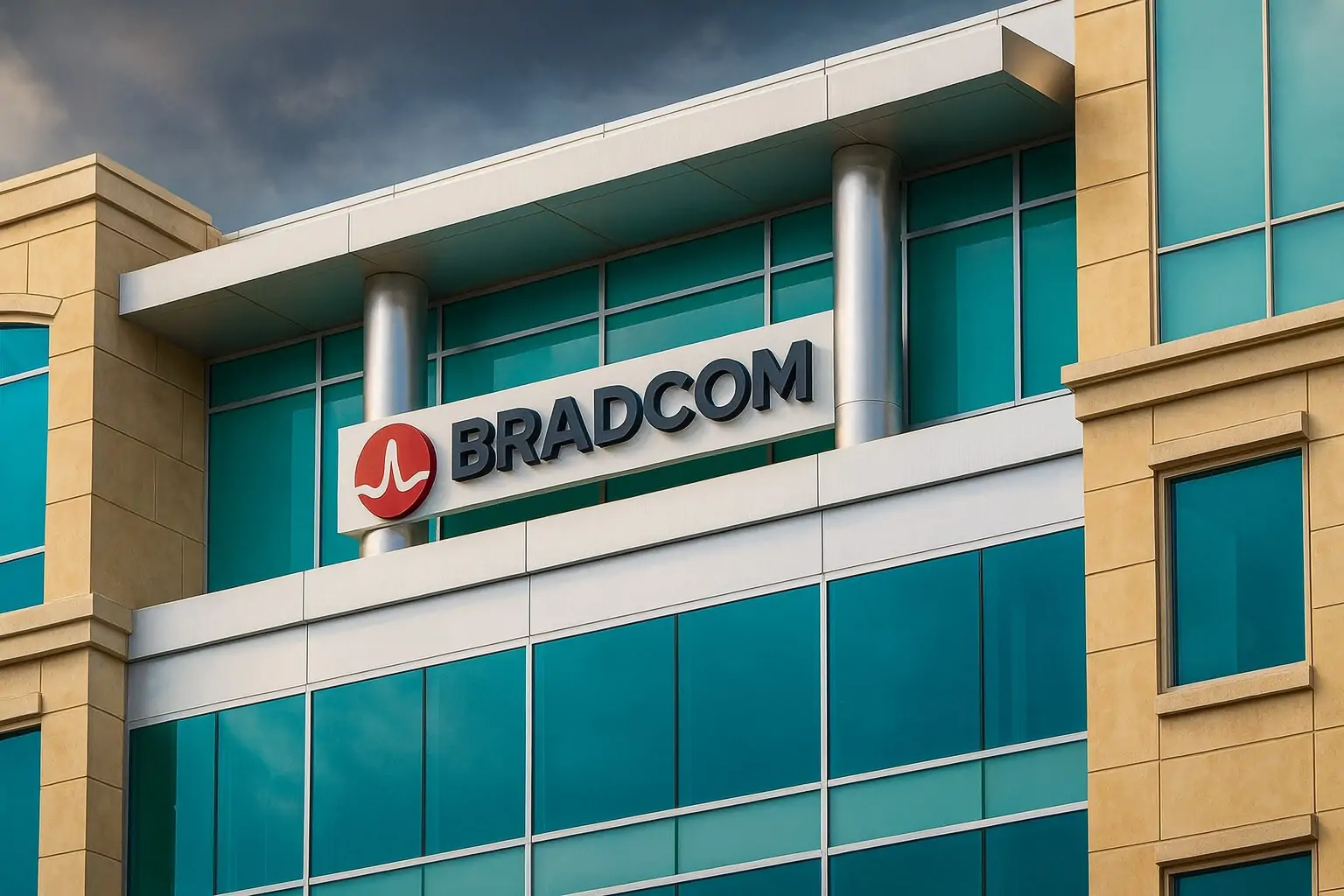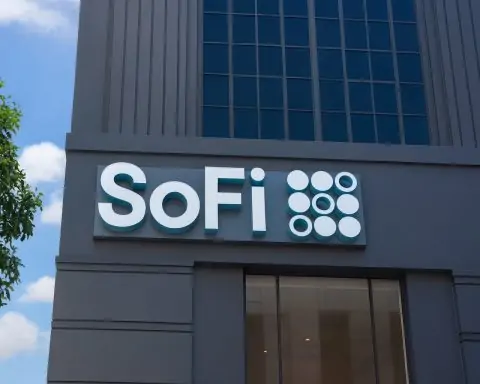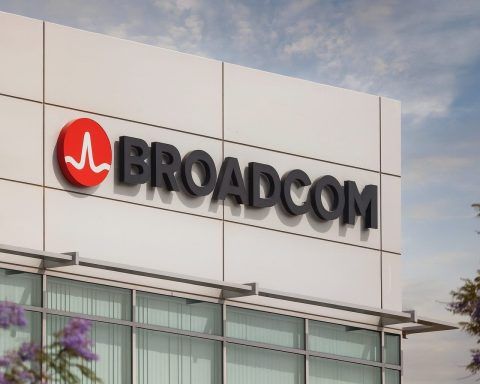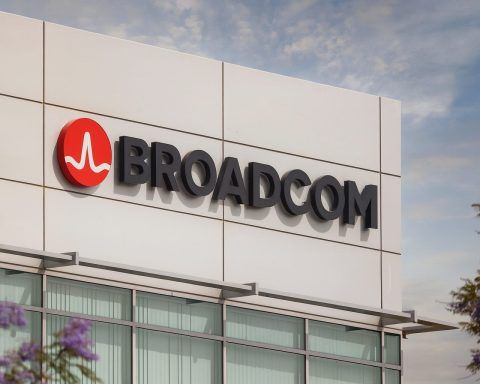Broadcom Inc. (NASDAQ: AVGO) is back in the market’s spotlight on Thursday, November 20, 2025, as investors pile into the stock on a powerful mix of new AI‑infrastructure products, bullish AI sentiment after Nvidia’s earnings, and ongoing legal noise around its VMware software business.
Broadcom stock today: AVGO extends its AI rally
As of the latest trade on Thursday, Broadcom shares are changing hands around $354 and are up roughly 3% over the past 24 hours, according to TradingView. Over the last year the stock has gained more than 110%, and Broadcom’s market capitalization now sits near $1.7 trillion. [1]
The current price leaves AVGO just under 10% below its late‑October record high around $386, with a 52‑week range of roughly $138 to $386. [2]
Institutional investors continue to dominate the shareholder base. A fresh filing summarized today by MarketBeat shows Vanguard Group owning about 483.4 million Broadcom shares, or 10.28% of the company, after adding more than 6.2 million shares in the latest quarter. Overall, institutions control roughly 76% of the float. [3]
At the same time, smaller firms such as Invenio Wealth Partners have trimmed positions, while others have initiated or increased stakes, highlighting active institutional rotation rather than a simple one‑way trade. [4]
The headline driver: world’s first quantum‑safe 128G SAN for AI workloads
The biggest product catalyst behind today’s move is Broadcom’s Brocade Gen 8 storage‑networking launch, announced yesterday and amplified across markets today.
In a press release distributed via Nasdaq, Broadcom unveiled: [5]
- Brocade X8 Directors – modular, high‑end Fibre Channel directors that can scale up to 384 × 128G ports for large AI‑driven data centers.
- Brocade G820 56‑port switch – a compact 1U Fibre Channel switch offering 56 × 128G SFP+ ports for edge or top‑of‑rack deployments.
- 128G performance and ultra‑low latency, designed to eliminate I/O bottlenecks for high‑transaction, AI and analytics workloads.
- Quantum‑safe security: 256‑bit “quantum‑resistant” encryption plus post‑quantum cryptography algorithms aimed at protecting data from future quantum computers.
- Embedded SAN AI: features such as SAN Fabric Intelligence for end‑to‑end visibility and Adaptive Traffic Optimizer for dynamic load balancing and automated troubleshooting.
Broadcom says both products are available now, with OEM partners – including Dell, HPE, IBM, Lenovo and NetApp – expected to ship Gen 8‑based solutions over the next several quarters. [6]
Coverage from Investing.com and other outlets underscores how this “world’s first 128G Fibre Channel platform for AI workloads” fits squarely into the company’s strategy: own the storage and networking plumbing of AI‑heavy data centers, not just the accelerators themselves. [7]
Markets have taken notice. Multiple equity news services report Broadcom shares jumping about 4.1% in Wednesday’s session, followed by another ~3–4% pre‑market spike on Thursday, before settling into the mid‑$350s during regular trading. [8]
Nvidia’s blockbuster earnings give AI chipmakers another tailwind
Today’s enthusiasm for AVGO isn’t happening in a vacuum. Nvidia’s latest quarterly report cleared a high bar, easing fears that the AI trade had turned into a bubble and sparking a broad rally in semiconductor names.
U.S. index futures and major chipmakers surged after Nvidia forecast another quarter of strong sales, with Broadcom among the AI‑adjacent beneficiaries in pre‑market trading, according to Reuters and other market wraps. [9]
For Broadcom, Nvidia’s beat is less about direct competition and more about confirming a simple thesis: AI infrastructure spending is still ramping, and hyperscalers are increasingly diversifying their compute stacks across GPUs and custom accelerators – including Broadcom’s XPUs and TPUs with partners like Google and OpenAI.
VMware and NEC: cloud software is the second engine of growth
While the headlines focus on chips and switches, Broadcom’s VMware business and cloud‑software stack remain the other half of its growth story.
On November 18, the company announced a deeper strategic partnership with NEC to drive adoption of VMware Cloud Foundation (VCF) in modern private‑cloud deployments. [10]
Key points from that deal:
- NEC will act as a “Client Zero” for VCF – running it internally to build deep implementation expertise, then offering VCF‑based infrastructure and managed services to customers.
- The partnership aims to help enterprises in Japan and globally modernize private clouds while supporting AI, machine‑learning and data‑intensive workloads on a unified platform.
- Broadcom states that nine of the top 10 Fortune 500 companies already use VCF, underscoring its centrality in the new VMware strategy. [11]
Analysts at Futurum Group note that VMware’s transition to VCF‑centric subscriptions has pushed infrastructure software revenue up 17% year‑on‑year, with segment gross margins above 90% and operating margins in the high‑70s – a powerful complement to Broadcom’s capital‑intensive semiconductor franchise. [12]
AI chips, OpenAI mega‑deal and Q3 earnings: the backdrop to today’s move
Underneath today’s trading action is a business that has already been reshaped by AI.
Broadcom’s Q3 FY 2025 results (reported in September) showed: [13]
- Record revenue of about $16.0 billion, up 22% year‑over‑year.
- AI semiconductor revenue of $5.2 billion, up 63% YoY – the tenth straight quarter of AI‑chip growth.
- Infrastructure software (largely VMware) at $6.8 billion, up 17% YoY, with very high margins.
- Management guidance for Q4 FY 2025 revenue around $17.4 billion, with AI chip sales expected to reach $6.2 billion.
On top of that, Broadcom has booked some of the largest custom‑AI orders in the market:
- A widely reported multi‑billion‑dollar, 10‑gigawatt AI accelerator collaboration with OpenAI, where OpenAI designs the chips and Broadcom develops and deploys them from 2026 through 2029. [14]
- A $10 billion XPU rack order from a fourth major hyperscale customer, which some analysts believe is linked to that OpenAI partnership. Together with Google and other existing clients, this pushes projected AI revenue to roughly $30–32 billion in FY 2026, according to one detailed forecast. [15]
Those numbers help explain why Trefis and other analyst platforms say Broadcom shares have more than doubled over the past year, even as its price/earnings multiple has actually compressed thanks to faster earnings growth. [16]
Legal overhang: Fidelity’s VMware lawsuit and regulatory scrutiny
The bullish narrative does come with a growing legal and regulatory overhang focused on VMware licensing and support.
Earlier this month, a Reuters report detailed how Fidelity’s National Financial Services unit sued Broadcom, alleging that new VMware subscription terms could cut off access to critical software that underpins trading and account systems used by roughly 50 million customers. Fidelity warned that losing access on Broadcom’s original timeline could cause “massive outages” and disrupt the broader financial markets. [17]
Broadcom has since agreed, in a court filing, to extend Fidelity’s access to the software into January 2026, buying time for judicial review. [18]
This isn’t Broadcom’s first clash over VMware terms. In July 2025, a Dutch court ordered the company to support VMware customers migrating away after an 85% price hike, highlighting regulatory concern over its licensing tactics in Europe. [19]
For now, investors appear willing to look past these disputes, but they remain a key risk factor:
- Adverse rulings could force Broadcom to soften its pricing model, denting the high‑margin software story.
- Prolonged litigation could invite further regulatory scrutiny in the U.S. and EU, especially as VMware is deeply embedded in critical financial and public‑sector infrastructure.
Today’s trading action reflects this duality: the stock is rallying on AI infrastructure momentum even as coverage repeatedly flags the Fidelity case as a “legal overhang” tied to VMware. TechStock²+1
Analyst positioning: upside – but less “cheap” than before
Today’s coverage also leans heavily on fresh analyst commentary:
- A Trefis report out today highlights catalysts for “the next big move” in AVGO: accelerating XPUs for hyperscalers, a deepening VMware subscription base, and AI‑networking leadership with platforms like Tomahawk 6 and Jericho 4. [20]
- A separate Seeking Alpha earnings preview argues that Broadcom is likely to beat Q4 expectations again, but notes that the stock’s current valuation implies only about 7% near‑term upside versus the author’s 15% hurdle for a “Buy” rating. [21]
- MarketBeat’s institutional‑ownership piece lists a consensus “Buy” rating and an average target price in the low‑to‑mid $370s, with some brokers already lifting targets into the $400–$480 range on the back of the OpenAI and hyperscaler wins. [22]
Put simply, Wall Street largely likes Broadcom, but the easy money from multiple expansion has probably been made. Future gains need to be earned through continued execution in AI silicon and VMware‑powered software.
Key risks investors are watching
Despite today’s surge, coverage around AVGO keeps circling back to a few core risks:
- Valuation & cyclicality
- Even after some multiple compression, Broadcom still trades at a rich earnings multiple relative to the broader market, and AI‑infrastructure cycles can be volatile. [23]
- Customer concentration
- A large portion of AI revenue comes from a handful of hyperscale customers (Google, Meta, OpenAI and others). Any shift in their in‑house chip roadmaps or supplier mix could hit growth. [24]
- Regulatory and legal pushback around VMware
- The Fidelity lawsuit, prior European cases, and broader customer complaints over VMware price hikes could crimp software margins or lead to mandated changes in Broadcom’s licensing model. [25]
- Competition in AI hardware
- Nvidia still dominates GPU compute, while AMD and hyperscalers continue to invest in their own accelerators. Broadcom’s strength in custom ASICs and networking must keep pace with a fast‑moving landscape. [26]
What today’s news means for AVGO investors
For investors tracking Broadcom on November 20, 2025, today’s tape tells a clear story:
- Bullish side:
- The Gen 8 128G SAN launch cements Broadcom as a core supplier of secure, AI‑ready data‑center networking and storage.
- AI semiconductor momentum remains strong, with Q4 guidance pointing to another record quarter and multi‑year visibility from the OpenAI and hyperscaler deals.
- The VMware + NEC partnership showcases how Broadcom is turning VMware into a recurring‑revenue engine for AI‑capable private clouds.
- Caution flags:
- Valuation is no longer cheap, and several analysts think upside from here will be more incremental.
- Legal and regulatory pressure around VMware is intensifying, particularly with Fidelity’s lawsuit and European pushback.
For long‑term investors, Broadcom increasingly looks like a two‑engine AI infrastructure giant – chips plus cloud software – but one that now has to navigate legal complexity and high expectations as carefully as it designs its silicon.
This article is for informational purposes only and does not constitute financial or investment advice. Always do your own research or consult a licensed financial adviser before making investment decisions.
References
1. www.tradingview.com, 2. www.investing.com, 3. www.marketbeat.com, 4. www.marketbeat.com, 5. www.nasdaq.com, 6. www.nasdaq.com, 7. www.investing.com, 8. www.ainvest.com, 9. www.reuters.com, 10. www.globenewswire.com, 11. www.globenewswire.com, 12. futurumgroup.com, 13. futurumgroup.com, 14. openai.com, 15. www.tradingnews.com, 16. www.trefis.com, 17. www.investing.com, 18. www.investing.com, 19. www.networkworld.com, 20. www.trefis.com, 21. seekingalpha.com, 22. www.marketbeat.com, 23. seekingalpha.com, 24. futurumgroup.com, 25. www.investing.com, 26. www.tomshardware.com










